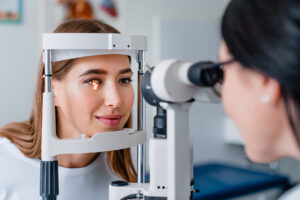
Vision is the dominant sense for humans. Compared to other animals, humans devote very little brain activity to smell, taste, hearing, or touch. But one of the most important tasks of the human brain is to process visual information.
When you injure your eyes or the brain structures dedicated to vision, you will suffer a profound and catastrophic loss of function. You will lose the ability to drive and perform many of the activities that give you independence, like shopping for necessities. And you will need to relearn everything from reading to cooking.
What Are the Structure and Function of Your Eyes?

Your eyes are extensions of your nervous system. In this sense, you can think of your eyes as specialized nerves for collecting light information.
Your eyes sit in the orbital sockets of your skull. The orbitals protect your eyes. The thin walls surrounding your eyes also guide their movement.
Muscles connect your eyes to the orbitals. These muscles move your eyes so you can follow a moving object without moving your head.
The eyeball or globe has an outer impermeable membrane. The globe contains all the structures needed for vision. It also encloses a hollow space filled with fluid. This hollow space is just as important as the physical structures because it provides a place for light to travel and focus on the back of the globe.
The cornea sits at the front of the eye. The cornea is a clear covering that protects the eye. It also begins the process of focusing the light entering the eye.
The iris sits behind the cornea. The iris is a muscle that opens and closes an aperture called the pupil. The adjustment of this aperture determines how much light enters the globe.
The lens rests behind the iris. The lens focuses light passing through the iris. Muscles pull on the lens to change its shape. This change alters where light rays focus.
All these structures cooperate to project a sharp image onto the retina. The retina is a coating of light-sensitive cells that sits at the back of the globe. The retina includes cells to detect light and color.
The optic nerve connects to the retina. Light data collected by the retina get transmitted along the optic nerve to the occipital lobe of the brain. There, the light data gets interpreted as an image.
How Do Eye Injuries and Blindness Happen?
Your eyes can get injured in many ways, including:
Penetrating Trauma
This type of trauma happens when a foreign object pierces your eye. In addition to tearing through the eye tissues, the object can lodge in the eye.
These injuries are common in workplace accidents. Rocks, nails, or other objects can get propelled into the eye, causing permanent damage.
Blunt Trauma
Blunt trauma occurs when you hit your eye with a blunt object. The impact can tear tissues and break bones.
Blunt force injuries can happen in falls. In particular, a trip and fall accident can send you stumbling and falling forward.
Debris
Debris in your eye might not necessarily penetrate the globe, but it can interfere with the muscles, blood vessels, and nerves that connect to the eye. Debris can also damage the surface of the cornea and globe.
You can get debris in your eye in a motorcycle accident. If you do not wear eye protection or your glasses get knocked from your head during the accident, gravel, glass fragments, and other debris can fly into your eyes.
Burns
Burns happen when a chemical reaction destroys body tissues. Your eyes can get sprayed with hot or caustic fluids during industrial accidents.
What Are Some Examples of Eye Injuries?
Eye injuries can take many forms depending on the structures that get injured. Examples of common eye injuries include:
Corneal Abrasion
Debris in your eye can scratch the cornea.
Symptoms of a corneal abrasion include:
- Pain
- Red and watery eyes
- Blurry vision
Fortunately, the cornea can heal from most abrasions. Your doctor may prescribe antibiotic eye drops to reduce the risk of infection. You may also need to rest your eye for at least a few days while your cornea heals.
Fractured Orbital
A powerful blunt force to your face can fracture the orbital bones that surround your eye. Sometimes, these fractures cause your face to swell around your eye. But once the swelling goes down, your vision returns to normal.
In other situations, the orbital fracture can affect your vision. Bone fragments can tangle in your eye muscles, nerves, or blood vessels. If these structures get severed, you will lose the ability to move your eye.
If you fracture the orbital bones inside the eye socket, the globe may shift out of place. Since your eyes no longer align, you may suffer double vision.
Ruptured Globe
A ruptured globe happens when an object penetrates the eyeball or a powerful impact causes it to burst. A ruptured globe will almost always result in some vision loss. But doctors can sometimes repair the rupture and preserve at least some of your vision.
Detached Retina
A strong blow to the eye or head can cause the retina to tear from the back of the eyeball. When it separates from the globe, the retina loses its blood supply. Without circulation, the retinal tissue dies. If doctors cannot reattach the retina before the cells die, you will suffer permanent blindness in that eye.
Traumatic Brain Injury
A traumatic brain injury is not an eye injury. But it can cause blindness. If your visual cortex gets damaged, your brain cannot receive or process visual data. The danger of this injury is that you could suffer total blindness despite having two functioning eyes.
How Can You Get Compensation for an Eye Injury?
You can pursue personal injury compensation for eye injuries that result from someone else’s actions. You must prove the other person acted negligently in causing your injury. Negligence means that they failed to act with reasonable care.
Thus, suppose someone ran a red light and smashed into your motorcycle. If the ensuing head injury resulted in blindness in one of your eyes, you could pursue a compensation claim against the negligent driver.
To discuss the compensation you can pursue your eye injuries and vision loss, contact the Jay Murray Car Accident and Truck Accident Lawyers for a free consultation at (214) 855-1420.
